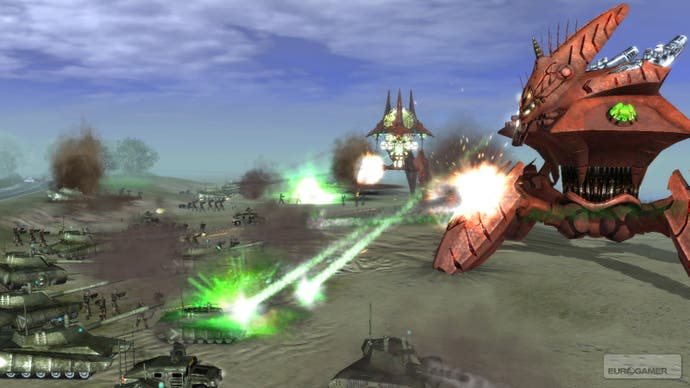Universe at War: Earth Assault
Mars Attacks - and so does everyone else.
There is a horrible, horrible section near the start of Universe at War where you suspect that perhaps developers Petroglyph don't have their collective tongue firmly wedged in cheek. Just for a few minutes, it seems entirely plausible that the team has created a game script plastered in a heavy layer of over-familiar clichés and sci-fi homages - and that it means every single word of it, without a hint of irony on the landscape.
The feeling passes, thankfully - but the fact that it's there at all is a demonstration of how close to the wind Universe at War sails at times. We're certain... Well, we're almost certain that the game is intended as a kitsch, over the top pastiche of the science-fiction games and films of yesteryear, like Mars Attacks with more resource management. At least, we hope so.
Mild suspicions regarding the intent of the story and script writers aside, Universe at War does a number of things right, and it's worth making sure those are writ large from the outset. Firstly, it dispenses entirely with the idea of plucky humans fighting off an interstellar invasion. In this game, humanity forms the tutorial levels - the real fighting is all about the aliens.

So, you control a band of US marine types for long enough to learn the controls - and then they're promptly shoved to one side when it becomes clear that the first remotely powerful alien unit to come along will annihilate them. The game proper only begins when the Novus, a race of gleaming silver robots, turn up to challenge the invasion of Earth by the Hierarchy, a race of giant multi-legged biomechanical walkers.
Later on, the Masari turn up - they're a race of incredibly posh-sounding high-tech types who fell asleep inside the Earth ages ago and are annoyed by the racket the other two are making. Throughout all of this, humanity's main role is to run around in the background screaming - with no sign whatsoever of Bill Pullman in a biplane. Music to our ears.
A Lesson from Future History
The second thing that Universe at War gets right is that it takes the incredibly clichéd idea of a rock-paper-scissors set of RTS races, combines it with three of the most hackneyed science-fiction concepts imaginable for the races themselves - and then somehow turns out three of the most extraordinarily innovative forces we've seen in a strategy game in years.
You could, for instance, characterise the Novus as being the Zerg race of the trio - but you'd be a long way wide of the mark. Their units are cheap and low-powered (although surprisingly effective against the right kind of targets, especially if you learn to use their special attacks at the right moments), and their basic attack pattern is certainly to swarm enemy forces in a sea of infantry.

However, their differences from Starcraft's lovable xenomorph horrors are more important than the similarities. The Novus construct an array of slender towers all over the map, creating an inter-linked grid - and can then move their forces almost instantaneously along this grid, dropping down a full attack force miles away from their base in seconds. The fully automated resource-collection units also travel along this grid, making them into near-impossible targets for enemies.
Lined up against any conventional RTS faction, the Novus would seem shockingly unfair. You can't fight them in the normal manner, inching across the map and claiming strategic positions as you advance. They don't have supply lines that you can cut. Indeed, the only way you can do them real damage is to assault their base.
Just as well, then, that the Hierarchy are just as innovative and unusual in their own right. They are yin to the Novus' yang, focused on three absolutely gigantic walking structures both for attacking power and for unit production. In essence, the Hierarchy have a mobile base that's bristling with weaponry - giving you the ability to walk your barracks right up to the front lines and start churning out units, while simultaneously pounding the enemy with heavy cannons.

The final race are the vaguely mystical Masari - who are arguably the most conventional of the races, being largely focused on base-building and research. However, they are specifically tuned to appeal to one aspect of RTS gaming. Unlike the other two races, the Masari are designed for "turtling" - the strategy of building a complex, well-defended base, and allowing your enemies to smash their forces up against your walls and turrets while you beaver away on super-weapon research inside.
The three factions are vastly more differentiated than even Starcraft's races, and yet seem perfectly well balanced. That's the mark of a great RTS game, we reckon - one which offers three utterly different play experiences but keeps them balanced and fair, so that your choice in multiplayer can be based entirely on your preferred style.
The third thing which Universe at War definitely gets right is the range of research and strategic options it gives to players. The branching research tree offers very different strengths and weaknesses, and you'll need to modify your strategy as you progress along the tree to allow for the choices you've made - or to defend against your opponent's research choices. At its best, this turns games into a tense experience, forcing you to adapt constantly rather than pursuing a single strategy to victory.


